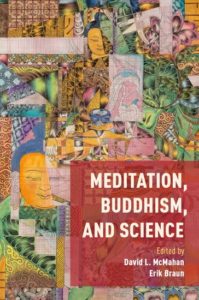
Meditation, Buddhism, and Science
Edited by David L. McMahan and Erik Braun
Oxford University Press, 2017
272 pages; $24.95
Scientific research on meditation, and as a consequence the popular discourse on contemplative research, has to-date largely focused on the individual. As a consequence, we find few studies that seriously consider the contexts of environments, social relations, and cultures in which meditation is practiced as well as the worldviews, ethics, and metaphysics that shape an interior contemplative life.
Largely in response to this inadequacy, the new book, “Meditation, Buddhism, and Science,” calls for a critical look at the science of Buddhist-informed meditation by situating contemplative research in context. The collection of essays is an outcome of a Contemplative Studies Fellowship from the Mind & Life Institute that brought together scholars in the humanities to think critically about how the convergence of Buddhism and science can advance with a deeper understanding of context. As the editors’ remark in their introduction, the essays share a “concern that the scientific study of Buddhist and Buddhist-derived meditative practices has been too narrowly construed and often neglects essential social, cultural, and historical contexts.”
“While the book does not present a single vision or unified voice around the current state of the field, each essay stands on its own to give a glimpse into the horizon of the Buddhism and science interface.”
The ten essays in the volume are distinguished by the diversity of perspectives presented and the accessibility of the material. Erik Braun, an associate professor of religious studies at the University of Virginia and one of this book’s editors, examines the cultural adaptation of Mindfulness-Based Stress Reduction (MBSR) in his essay, “Mindful but Not Religious,” making the point that Kabat-Zinn’s usage of language intentionally describes mindfulness to create an enchantment that feels scientific and secular while retaining its Buddhist touch. In her essay, “Mind the Gap,” the anthropologist Joanna Cook from the University College London reflects on observations from her fieldwork at a two-year Mindfulness-Based Cognitive Therapy (MBCT) therapist-training program in the United Kingdom, underscoring how popular conceptions of science inform understandings of meditation. Evan Thompson, professor of philosophy at the University of British Columbia, publishes thoughts from his keynote address at Mind & Life’s 2016 International Symposium for Contemplative Studies where he calls for a move away from brain-centric reports on meditation studies and toward a science that would give attention to the cultural practices that shape cognitive skills in meditation. Echoing the call to move away from a brain-centered science of meditation, William Waldron, professor of religion at Middlebury College, raises philosophical questions in his essay, “Reflections on Indian Buddhist Thought and the Scientific Study of Meditation.” Other essays in the book address topics that include how meditation works differently in different cultural contexts, pop notions of happiness, non-self and spirits in Thai Buddhist mindfulness, mindful sex, and why it matters that mindfulness is Buddhist.
The editors and authors of this book deserve praise for pioneering new territory. Though it is by no means expected that any single book would address all the issues in the contemporary science of meditation, as a whole, the essays in this book offer a fantastic response to a wide range of these issues. Most critically are the emphasis on brain-centered effects of meditation, the lack of serious consideration given to the impact of culture on practice, consumer forces that drive pop mindfulness, the scarce integration of humanistic scholarship with science, and issues of cross-cultural adaptation of meditation.
A hope for the future is that scientists, humanists, and contemplatives will one day collaborate on such a volume, if not co-author essays. While the book does not present a single vision or unified voice around the current state of the field, each essay stands on its own to give a glimpse into the horizon of the Buddhism and science interface. And while there is no in-depth appraisal of any single meditation practice or tradition, the multiple perspectives represented in the volume serve as stepping stones to guide and move this dialogue forward.
See the full review of “Meditation, Buddhism, and Science” to be published in the Fall 2018 issue of Buddhadharma: The Practitioner’s Quarterly.”


